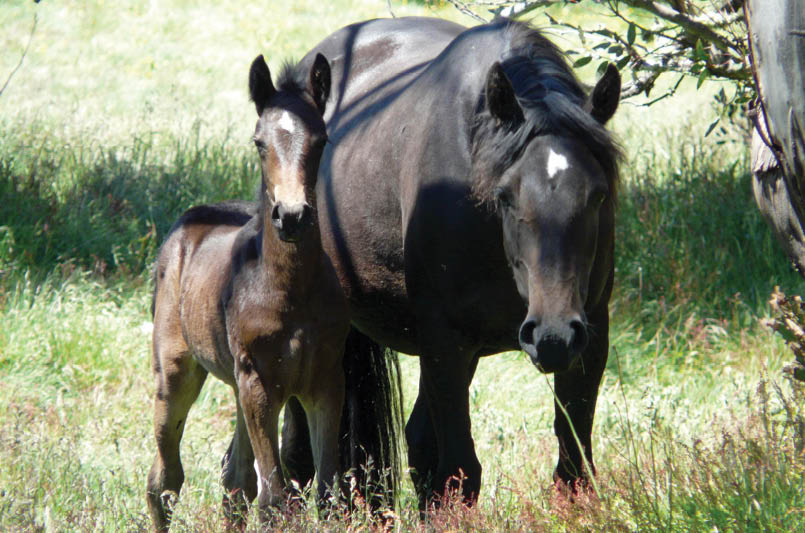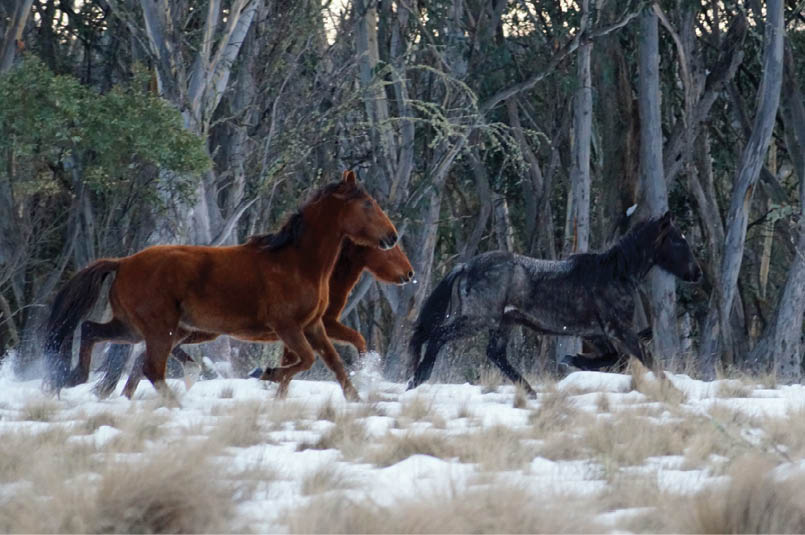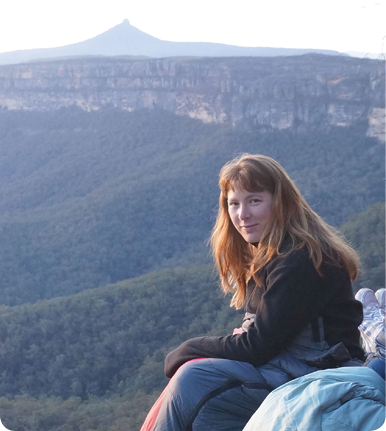{{{description}}}

In the winter of 2013 while cross-country skiing at the fatefully named Dead Horse Gap we stumbled across a mob of starving horses. They had been trapped above the snow line after the blizzard, and the tracks in the snow told us that they were so exhausted that they’d barely moved a few dozen metres in the past week. One of the mob had already fallen, and carnivores had moved in on the carcass. Subsequent accounts revealed that the remaining animals had taken a further two weeks to finally succumb to the elements.
Clearly, natural attrition was brutal.
With only a basic understanding of wild horse management, I decided to research the issue, and have been following the debate since then. The 2016 Plan was released for public comment after a long and arduous process of reviewing the 2008 plan. The review included extensive community consultation and an independent review panel of expert professionals, and the most up to date aerial surveys of population counts. The 2016 Plan is on public display until 19 August, with an accessible and inoffensive Questions and Answers Information sheet for those who want to provide quick responses on the most contentious subjects. Yet media articles about the 2016 Plan are always accompanied by vitriol below the line, as public commentators variously bemoan the concept of horses in national parks at all or claim that the NSW National Parks and Wildlife Service (NPWS) is a corrupt institution intent on killing all the horses.
So contentious is the issue that the 2008 plan review report (included with the 2016 Plan) described that even naming the horse was a careful decision in balancing views:
“In this Review, NPWS refers to the horses as ‘wild horses’ in an effort to maintain balance between environmental and horse advocacy stakeholder groups that regard the terms ‘brumby’ or ‘feral’ as either romanticising or being derogatory, depending on the viewpoint. Use of such terms by NPWS, it is argued by stakeholders, could cloud or influence community opinion. This in itself is an indicator of the level of controversy, debate and emotion that is associated with this management issue.”
Understanding both sides of the argument is an important first step towards community support for wild horse management, and helps to tackle some of the misinformation being spread. In this article I want to address what wild horses mean to the community, to help contextualise why there has been such a contested response to the 2016 Plan, before I describe the current horse management practices. As such, because I am addressing this to a bushwalking audience, I’ll start with what is usually the other side of the debate: the pro-brumby arguments.
The Brumby PerspectiveHorses arrived in Australia on the First Fleet in 1788, and have been a major part of the European settlement of the continent. From pastoralism in the high country to their use in war, horses have a special place in Anglo-Australian culture reflected in our literature, films and artwork. Abandoned or escaped horses made it into the alpine regions at least 150 years ago, and the word “brumby” for these wild horses has been in use since at least the 1880s. Contrary to popular beliefs about Sergeant James Brumby or derivations of Aboriginal words, the Australian National Dictionary states that word brumby is of unknown origin.
The connection between Anglo-Australian culture and horses runs deep. The creation of a specifically Australian sense of identity (as distinct from British) was taking place at the end of the nineteenth century across multiple cultural mediums, including the Heidelberg school of art, and bush ballads by Henry Lawson and A.B. “Banjo” Patterson. This identity solidified the relationship between the settler, the horse and the bush. Significantly, it also served to naturalise the settler: settlers were connected with horses, horses became a part of the landscape, therefore settlers were connected with the landscape. This cultural meaning for the wild horses is not explicit, but it helps to explain the unconscious drive behind the determination of brumby supporters to argue that horses have evolved in tune with the alpine region – a defence that is not extended to other feral animals.
“Abandoned or escaped horses made it into the alpine regions at least 150 years ago ...
BWA August 2016 | 63


management practices, have also influenced their perceptions and motivations, and their relationships with the organisation. This history, their sense of ownership of the issue and the idea that theirs are the only credible views all impact on their engagement and interaction with NPWS on this issue. Their refusal to acknowledge the right of NPWS to publish factsheets about this issue, on the basis that they do not agree with the views being presented, is an example of this.”
A History of Wild Horse ManagementIn 1944 Kosciuszko was declared a State Park, and in 1967 the area became a National Park. Cattle grazing was phased out between 1949 and 1972, but with wild horse numbers rising, formal management of them was introduced in the 1970s through licensed brumby running. Concern about the stress caused to the wild horses by brumby running grew through the 70s, and in 1982 the Plan of Management declared a ban on brumby running due to animal welfare and the risk to participants. Horse numbers increased, and by the 1990s it was clear that the population needed different management.
The NPWS developed the first Horse Management Plan for the KNP Alpine Area
in 2003. This plan noted the legislative responsibility of NPWS to control the impact of the wild horses on the landscape, which required a decrease in their population. The impact of horses is both direct herbivory (consumption of native plants), and degradation of natural habitats (which includes fouling waterways, accelerating gully erosion and trampling native vegetation). All studies of horses in the alpine region have concluded unambiguously that they do damage. This is simply because the landscape did not evolve with large hard-hoofed animals such as horses, and it is impossible for the horses not to make an impact.
Several strategies for controlling the population growth were considered. Trapping, roping and mustering were trialled. Leading the horses on a rope from a trap was discontinued early, as it was both high risk to personnel and volunteers and caused severe stress for the wild horses themselves. Since that time, all horses caught in the traps have been removed directly into transport (limiting trap setting locations to those accessible by road).
Stallion, CurrangoJessica Hancock
“This is simply because the landscape did not evolve with large hard-hoofed animals such as horses ...
BWA August 2016 | 65


A few years later, in 2008, a broader KNP Horse Management Plan was adopted. The objectives of this plan were straightforward: to exclude wild horses from areas of exceptional natural and cultural significance (Main Range, Yarrangobilly and Cooleman Plain); to reduce horse numbers; and to reduce horse numbers humanely. Unfortunately, the plan was actually quite unsuccessful in achieving these objectives. Horses moved into the sensitive areas specified, and areas where horses were removed were simply recolonised from neighbouring areas. Basically, horse numbers have increased markedly rather than being reduced at all (perhaps unsurprisingly, given that studies of horses elsewhere show that removing horses keeps their growth rate high and their populations healthy). Although NPWS did follow best humane practices in removing the horses, due to a low demand for wild horses, less than 20% of these went on to be rehomed.
Overall, the 2003-16 trapping and removal program removed 3183 horses from the park at a cost of $3.3 million, or about $1116 per horse. Of these horses, 583 (18%) were rehomed, while the rest were sent to a
knackery or abattoir for slaughter. The 2016 Plan also notes that there is concern for wild horse welfare in the multi-stage trapping and subsequent transportation system that can cause them prolonged stress, only for the great majority of them to be euthanised at the end of the process anyway. Over a similar period, the KNP horse population increased from 3000 in 2002 to 6000 in 2014. In short, trapping is not getting control over the number of horses.
Horse Management in Other ParksIt is instructive to look at other horse management strategies in different national parks in order to contextualise other solutions. For instance, in nearby Namadgi National Park in the ACT, horses were eliminated entirely in an aerial cull in 1987 that attracted public backlash. However, Namadgi was then kept relatively horse-free through passive trapping and monitoring, and caused no further controversy. The currently expanding KNP population threatens to thwart this if not kept in check.
Brumbies in the Victorian High Country, Falls CreekJessica Hancock
“... areas where horses were removed were simply recolonised from neighbouring areas.
66 | BWA August 2016

Guy Fawkes An even more dramatic backlash had been in response to the aerial shooting at Guy Fawkes National Park, north-east of Armidale in north-east NSW in 2000. Wild horse numbers had been increasing in the park over the 1990s, and mustering and trapping operations had not only failed to control numbers, but had caused injury and considerable stress for the animals involved. Fires and severe drought through the park in 2000 left the wild horses in a poor condition, and drove them into the open gullies and creek beds where their plight became obvious. The death of individuals and the ill health of the population at large, as well as the ease of accessing them in the confined open ground where they had relocated, made an aerial shoot the most humane response. An independent veterinarian looked at the deceased horses after the shooting and concluded that those examined had been killed humanely. Of the 606 horses shot over three days, one horse was found alive later, in spite of two bullet wounds in the killing zone of the heart/lungs. The suffering of this animal, as well as photographs of the deceased wild horses, sparked outrage and the RSPCA prosecuted the NPWS for aggravated cruelty.
New Zealand Kaimanawa HorsesAfter the Kaimanawa Horse was declared a protected species in New Zealand their numbers soared, and concern for the environment prompted a decision to reduce and control the population. In recognition of the public preference for mustering and rehoming, rather than the aerial shooting technique recommended by animal welfare groups, a muster and capture was done of 1069 horses. Many of these horses were in poor physical health (part of the impetus for the muster), and the sheer number of them outweighed limited public demand for wild horses. Consequently, very few of these animals were re-homed and most had to be euthanised, but annual musters to control the population since then have been more successful in rehoming the majority of the animals. Debate around fertility control
continues in New Zealand, but even with a tiny and controlled population of 300 horses this is seen as unfeasible. The musters have been biannual since 2010 to reduce the costs to the Department of Conservation.
The 2016 Draft Wild Horse Management PlanThe objective of the 2016 Plan includes reducing this population to 3000 in 5-10 years, and to a manageable 600 in twenty years time. The 2016 Plan information sheet says:
“The Plan is based on an integrated and adaptive pest management approach to be implemented in conjunction with other long term park management and control programs for pest species, such as pigs, deer, goats, rabbits, foxes and other introduced species. There are a range of humane and cost effective control methods proposed in the draft plan and the decision to use some or all will be taken to suit particular circumstances using the best available information at the time. It’s expected that different methods will be selected at different times depending on seasonal factors, location of the horses and population size.
Proposed control methods are:
trapping and rehoming
trapping and transport to knackery or abattoir
trapping then shooting at the trap site
aerial and ground mustering for rehoming
aerial and ground mustering for transport to knackery or abattoir
aerial and ground mustering then shooting at muster site
ground shooting
fertility control (in the longer term when populations are reduced)
fencing.”
“After the Kaimanawa Horse was declared a protected species in New Zealand their numbers soared ...
“... I am in doubt that natural attrition is the most humane method ...
BWA August 2016 | 67


One of the most contentious aspects of horse management seems to be aerial shooting. The Victorian RSPCA released a statement supporting an aerial shoot and calling on Parks Victoria to implement one in response to the suffering of the horses in overpopulated areas of the alpine region. After witnessing the slow death of the wild horses trapped by snow at the appropriately named Dead Horse Gap, I am in doubt that natural attrition is the most humane method, for the horses or for the environment of an overpopulated region before drought or snow drives the population of horses down.
If an aerial shoot improves the condition of the remaining horses, humanely euthanises the excess population, and causes less stress for the same result as mustering and trapping, why is this not considered a win-win for all involved? The answer is that this conclusion does not address any of the issues on the pro-brumby side of the debate. Jumping directly to aerial shooting skips the earnestly felt indigenisation of the horses that makes them a balanced and necessary part of the environment for brumby supporters. It skips the tradition of pastoralism and brumby running in the alpine region. And it skips the
emotional response that aerial shooting provokes in people. Our enjoyment of national parks is anthropocentric – we want to access them, walk through them, ski in them, take photographs of them. To invalidate equally anthropocentric forms of recreation such as brumby spotting and horse riding is to – pun intended – take the high horse on the issue.
The 2016 Plan acknowledges the cultural value of the wild horses, and responds directly to the concerns of brumby advocates. Indeed, the vision that opens the 2016 Plan is:
“To conserve the outstanding values of Kosciuszko National Park with the support of the community through active, adaptive and humane management of wild horses to minimise their adverse impacts on natural, cultural and visitor values, while acknowledging the cultural and social values of the Kosciuszko National Park wild horse population.”
Brumbies at Gooandra HomesteadJessica Hancock
“Jumping directly to aerial shooting skips the earnestly felt indigenisation of the horses that makes them a balanced and necessary part of the environment for brumby supporters.
68 | BWA August 2016
Jessica Hancock’s parents met through a bushwalking club, and she has been bushwalking since before her memories of these walks were even formed. Her executive roles with the UTas Bushwalking Club (Vice-president 2009-11), UWA Outdoor Club and the ANU Mountaineering Club (President 2015) have seen her living her love of the outdoors as dedicated procrastination from her studies, which currently involve completing a PhD in Literature at the ANU. She blogs about her adventures at wordsandwilds.wordpress.com, has recently started actually contributing to (instead of just reading) Bushwalk.com as Zingiberacea, and has even more recently joined the Tasmania Parks and Wildlife Service as a Host Ranger on the Three Capes Track.
And while the first two objectives of the plan reflect earlier plans (reduce horse numbers and impact; reduce the risk of adverse horse incidents), the third is devoted to community consultation.
But if brumby supporters were already off-side before the 2016 Plan and now refuse to read it, how can we talk to them about the future management of the park? This article is, I hope, a step towards bridging this language divide: if we can make the effort to understand the assumptions of brumby supporters, then we can at least not get them off-side when discussing wild horse management. Being informed about the issue is a step in the right direction – if you know the advantages of the Kaimanawa horse management, then you can talk about the same issue (wild horse management) without directly challenging the value of brumbies in Australia. But most importantly, we need to accept a compromise: while there is agreement that horses should be
kept out of the true alpine ecosystems, horses will never be completely removed from the sub alpine and montane regions of Australia. If the country was run entirely on scientific evidence with the accepted premise that a pre-1788 environment was superior and our modern cultural traditions (bushwalking and other activities that do not involve brumbies) were the only way the area could be enjoyed, then sure, maybe we could remove them. But Australia in 2016 has cultural traditions in the alpine wild horse, and while this is an Anglocentric cultural tradition, it is a tradition nevertheless.
In Australia, we do not simply have wild horses: we have brumbies. But through the active and humane management of these brumbies we can also have a future goal: the cultural tradition of Australian alpine recreation based on science and our appreciation of our endemic environment. And bushwalkers can lead the way.

“... while there is agreement that horses should be kept out of the true alpine ecosystems, horses will never be completely removed from the sub alpine and montane regions of Australia.
“But Australia in 2016 has cultural traditions in the alpine wild horse, and while this is an Anglocentric cultural tradition, it is a tradition nevertheless.

BWA August 2016 | 69